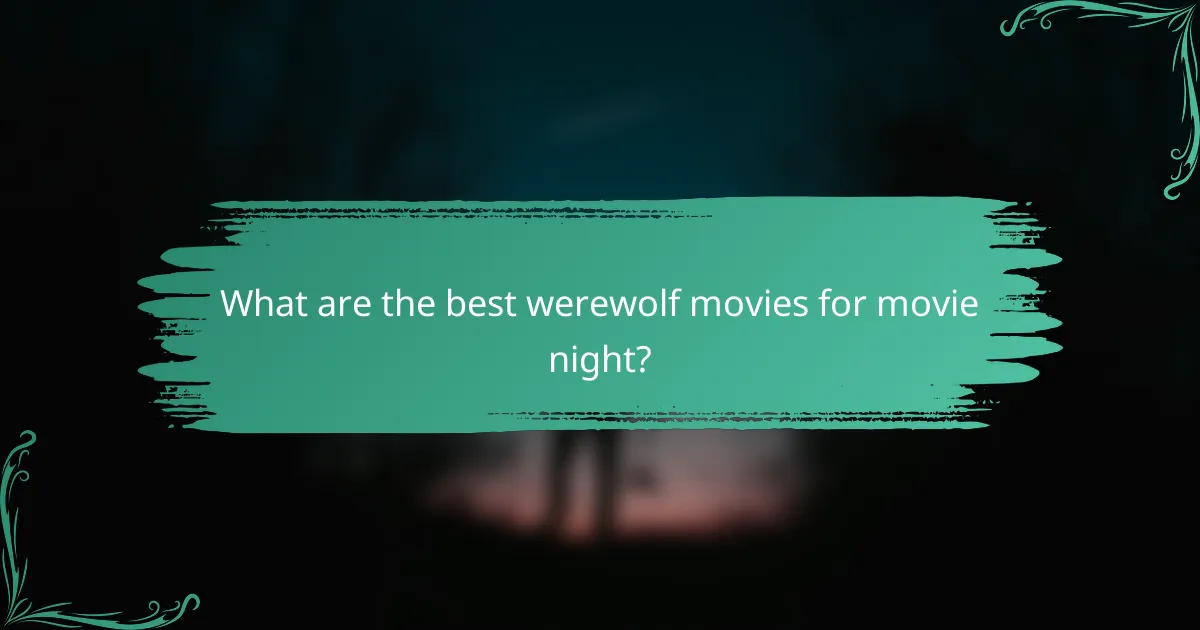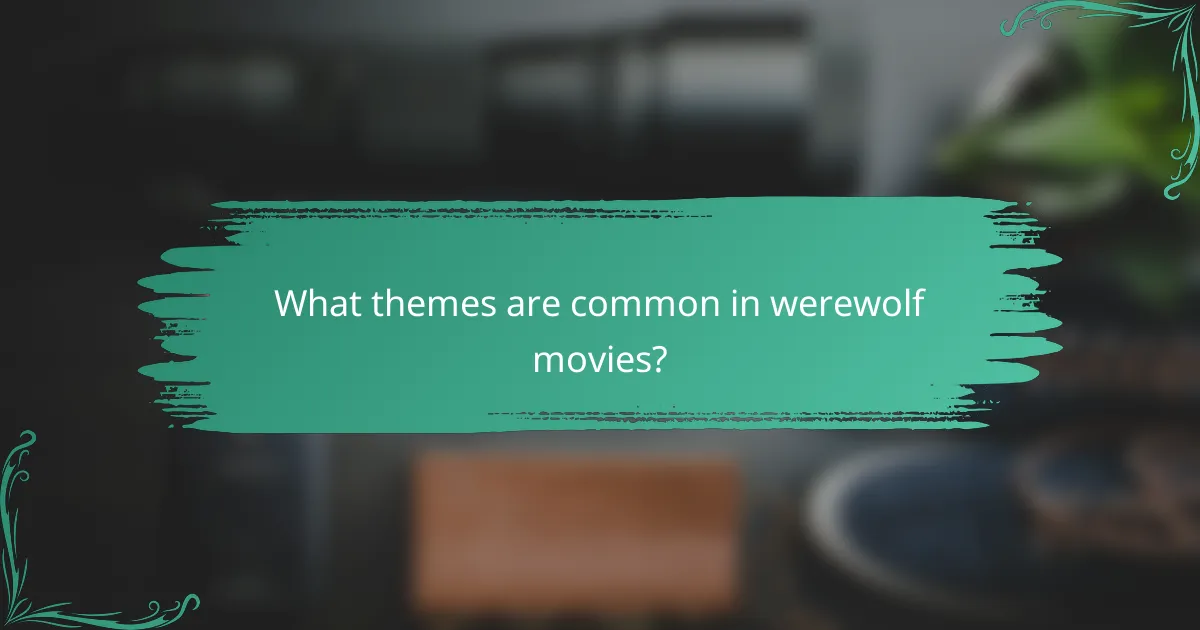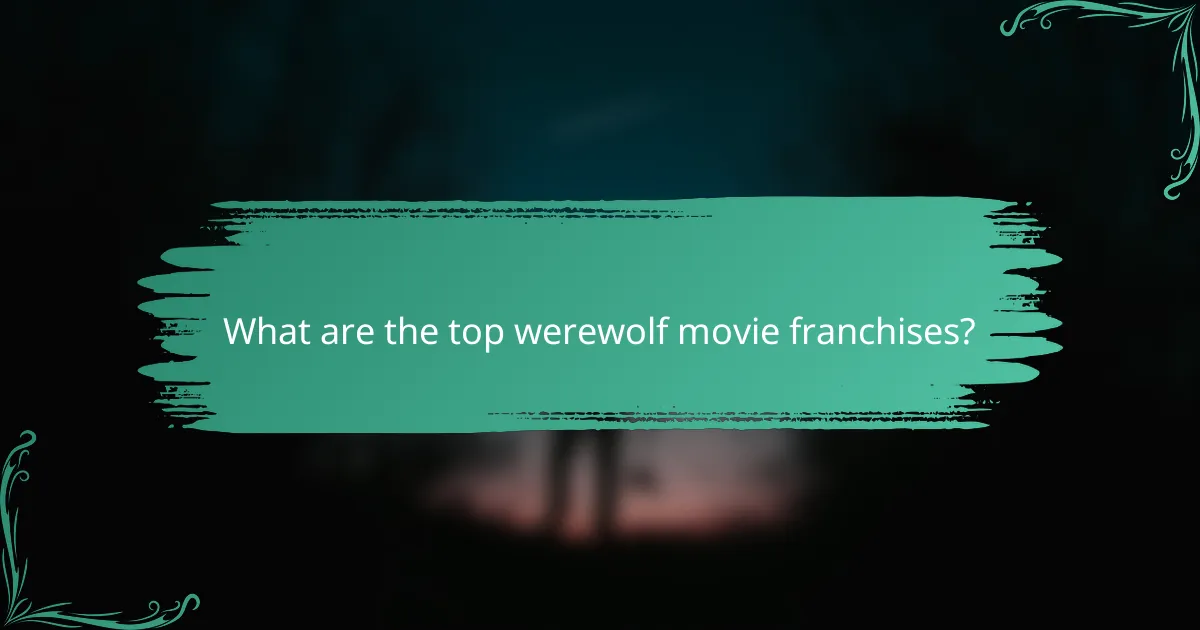Werewolf movies are a thrilling addition to any movie night, combining suspenseful narratives with engaging characters and a hint of horror. These films delve into themes of transformation and identity, often exploring the duality of human nature and the primal instincts that lie beneath. With their unique blend of mythological elements and visceral effects, werewolf films offer a captivating viewing experience that keeps audiences on the edge of their seats.

What are the best werewolf movies for movie night?
The best werewolf movies for movie night combine thrilling narratives with engaging characters and often a touch of horror. These films offer a mix of suspense, transformation, and sometimes dark humor, making them perfect for a captivating viewing experience.
American Werewolf in London
“American Werewolf in London” is a classic that blends horror and comedy seamlessly. The story follows two American backpackers who encounter a werewolf while traveling in England, leading to a series of terrifying transformations and darkly humorous situations.
The film is renowned for its groundbreaking special effects, particularly the transformation scene, which remains iconic. Its mix of chilling moments and witty dialogue makes it a must-watch for any werewolf movie enthusiast.
Dog Soldiers
“Dog Soldiers” is a British horror film that pits a group of soldiers against a pack of werewolves during a training exercise in the Scottish Highlands. This film stands out for its intense action and clever writing, combining military camaraderie with supernatural terror.
The practical effects and suspenseful atmosphere create a gripping experience. It’s a great choice for viewers looking for a more action-oriented werewolf film that doesn’t shy away from gore.
Ginger Snaps
“Ginger Snaps” offers a unique take on the werewolf genre by intertwining themes of adolescence and transformation. The story centers on two teenage sisters, one of whom undergoes a dramatic change after being bitten by a werewolf.
This film explores the metaphorical aspects of growing up and the challenges of female identity, making it both a horror movie and a coming-of-age story. Its clever script and strong performances make it a standout choice for a movie night.
Howl
“Howl” is a contemporary werewolf film that takes place on a train traveling through the English countryside. Passengers find themselves trapped and hunted by werewolves, leading to a tense and claustrophobic atmosphere.
The film effectively builds suspense and features strong character development, making viewers care about the fate of the characters. It’s an excellent pick for those who enjoy a modern twist on the classic werewolf narrative.
WolfCop
“WolfCop” is a unique blend of comedy and horror that follows a cop who transforms into a werewolf while investigating a series of bizarre crimes. This film embraces its absurdity, offering a fun and entertaining experience.
With its over-the-top action and humorous take on the werewolf mythos, “WolfCop” is perfect for viewers looking for something light-hearted yet thrilling. It’s an ideal choice for a movie night with friends who appreciate campy horror films.

What themes are common in werewolf movies?
Common themes in werewolf movies include transformation, identity struggles, isolation, and connections to mythology. These elements create a compelling narrative that explores the duality of human nature and the fears associated with losing control.
Transformation and Identity
Transformation is a central theme in werewolf films, often symbolizing the struggle between one’s human side and primal instincts. Characters typically undergo physical and psychological changes, reflecting their inner turmoil and identity crisis. This theme resonates with audiences as it explores the concept of self and the fear of losing one’s humanity.
For example, films like “An American Werewolf in London” showcase the protagonist’s horrific transformation, which serves as a metaphor for the challenges of adolescence and self-discovery. Viewers are drawn to the tension between the familiar and the monstrous, making transformation a powerful narrative device.
Isolation and Fear
Isolation is another prevalent theme in werewolf movies, often highlighting the characters’ alienation from society due to their condition. This sense of being an outsider amplifies the fear and anxiety associated with their transformations, as they grapple with the consequences of their actions. The fear of being hunted or misunderstood adds to the suspense and emotional depth of the story.
In films like “The Howling,” the characters experience both physical and emotional isolation, which heightens the horror of their situation. This theme serves as a reminder of the human need for connection and the dread of being alone in one’s struggles.
Mythology and Folklore
Mythology and folklore play a significant role in shaping the narrative of werewolf movies, drawing from ancient legends and cultural beliefs. These stories often explore the origins of werewolves, linking them to curses, supernatural forces, or moral lessons. By incorporating these elements, filmmakers tap into a rich tradition that resonates with audiences on a deeper level.
For instance, many werewolf films reference European folklore, where the werewolf is often depicted as a tragic figure caught between two worlds. This connection to mythology not only enriches the storytelling but also invites viewers to reflect on the cultural significance of these creatures throughout history.

How do werewolf movies compare to other horror genres?
Werewolf movies stand out in the horror genre due to their unique blend of mythological elements, character transformations, and visceral special effects. Unlike other horror films that may rely heavily on supernatural entities or psychological terror, werewolf films often explore themes of humanity, primal instincts, and the struggle between man and beast.
Unique Mythological Elements
Werewolf movies draw from rich folklore and mythology, often depicting the transformation of humans into wolves as a curse or a consequence of certain actions. This mythological backdrop provides a framework for exploring deeper themes such as identity, loss of control, and the duality of human nature.
Common elements include the full moon as a trigger for transformation and the presence of silver as a means to defeat the werewolf. These motifs not only enhance the narrative but also create a sense of shared cultural understanding among audiences familiar with the lore.
Character Development
Character arcs in werewolf films often focus on the internal conflict of the protagonist as they grapple with their dual identity. This struggle can lead to compelling storytelling, as characters must navigate their human emotions while confronting their animalistic instincts.
For instance, a character may start as a relatable individual but gradually transform into a monstrous figure, showcasing both physical and psychological changes. This development allows viewers to empathize with the character’s plight, making the horror more impactful.
Special Effects Techniques
Special effects in werewolf movies are crucial for bringing the transformation and the creature to life. Techniques range from practical effects, such as prosthetics and animatronics, to modern CGI, which can create more fluid and dynamic transformations.
Classic films often relied on makeup and practical effects to achieve realistic transformations, while contemporary films may use digital enhancements to amplify the horror. A blend of both techniques can create a more immersive experience, appealing to a wide audience and enhancing the overall tension of the film.

What are the top werewolf movie franchises?
The top werewolf movie franchises include the Underworld, Howling, and Teen Wolf series, each offering unique takes on the werewolf mythos. These franchises vary in tone, style, and audience appeal, making them popular choices for fans of horror and fantasy.
Underworld Series
The Underworld series blends horror with action, focusing on the war between vampires and werewolves, known as Lycans. Starting in the early 2000s, this franchise has produced several films that explore themes of betrayal, power, and survival in a dark, stylized world.
Key films include “Underworld” (2003) and “Underworld: Awakening” (2012), which showcase impressive visual effects and intense fight scenes. Fans appreciate the series for its strong female lead, Selene, and its intricate lore surrounding both vampires and werewolves.
Howling Series
The Howling series is one of the earliest werewolf franchises, beginning in the 1980s with the original “Howling” film. This series is known for its blend of horror and dark humor, often exploring the transformation and societal implications of being a werewolf.
With multiple sequels and spin-offs, the Howling franchise has experimented with different storytelling styles, from horror to comedy. While not all entries are critically acclaimed, the original remains a classic in the werewolf genre.
Teen Wolf Series
Teen Wolf, originally a film in the 1980s, was reimagined as a television series that aired from 2011 to 2017. This series targets a younger audience, combining supernatural elements with coming-of-age themes, romance, and friendship.
The show features Scott McCall, a high school student who becomes a werewolf and must navigate the challenges of adolescence while dealing with supernatural threats. Its success led to a dedicated fanbase and a revival film, showcasing the franchise’s lasting appeal.

What are the key characteristics of a great werewolf movie?
A great werewolf movie typically features a blend of strong character development, impressive special effects, and captivating storylines. These elements work together to create a thrilling and immersive experience for the audience.
Strong Character Arcs
Strong character arcs are essential in werewolf movies, as they allow viewers to connect emotionally with the characters. A well-developed protagonist often faces internal conflicts, such as grappling with their transformation and the moral implications of their actions.
For example, characters who evolve from innocent to monstrous can create a compelling narrative. Audiences appreciate seeing characters struggle with their dual nature, which adds depth to the story and enhances the overall impact.
High-Quality Special Effects
High-quality special effects are crucial for bringing the werewolf transformation to life. Effective use of practical effects, makeup, and CGI can elevate the visual experience, making the transformation both believable and terrifying.
Films that invest in top-notch effects often leave a lasting impression. Iconic transformations, such as those seen in classics like “An American Werewolf in London,” showcase how special effects can enhance the horror and excitement of the genre.
Engaging Storylines
Engaging storylines are vital for keeping the audience captivated throughout a werewolf movie. A successful plot often intertwines themes of horror, suspense, and sometimes even romance, creating a rich narrative tapestry.
Incorporating elements like a looming threat, a quest for redemption, or a battle against societal norms can make the story more compelling. Viewers tend to enjoy plots that not only focus on the werewolf’s terror but also explore the human condition and the consequences of the transformation.
